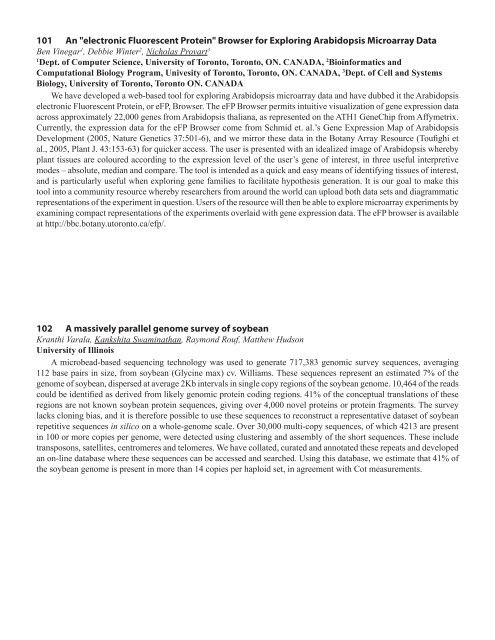75 Integrating Membrane Transport with Male Gametophyte ... - TAIR
75 Integrating Membrane Transport with Male Gametophyte ... - TAIR
75 Integrating Membrane Transport with Male Gametophyte ... - TAIR
You also want an ePaper? Increase the reach of your titles
YUMPU automatically turns print PDFs into web optimized ePapers that Google loves.
101 An "electronic Fluorescent Protein" Browser for Exploring Arabidopsis Microarray Data<br />
Ben Vinegar 1 , Debbie Winter 2 , Nicholas Provart 3<br />
1<br />
Dept. of Computer Science, University of Toronto, Toronto, ON. CANADA, 2 Bioinformatics and<br />
Computational Biology Program, Univesity of Toronto, Toronto, ON. CANADA, 3 Dept. of Cell and Systems<br />
Biology, University of Toronto, Toronto ON. CANADA<br />
We have developed a web-based tool for exploring Arabidopsis microarray data and have dubbed it the Arabidopsis<br />
electronic Fluorescent Protein, or eFP, Browser. The eFP Browser permits intuitive visualization of gene expression data<br />
across approximately 22,000 genes from Arabidopsis thaliana, as represented on the ATH1 GeneChip from Affymetrix.<br />
Currently, the expression data for the eFP Browser come from Schmid et. al.’s Gene Expression Map of Arabidopsis<br />
Development (2005, Nature Genetics 37:501-6), and we mirror these data in the Botany Array Resource (Toufighi et<br />
al., 2005, Plant J. 43:153-63) for quicker access. The user is presented <strong>with</strong> an idealized image of Arabidopsis whereby<br />
plant tissues are coloured according to the expression level of the user’s gene of interest, in three useful interpretive<br />
modes – absolute, median and compare. The tool is intended as a quick and easy means of identifying tissues of interest,<br />
and is particularly useful when exploring gene families to facilitate hypothesis generation. It is our goal to make this<br />
tool into a community resource whereby researchers from around the world can upload both data sets and diagrammatic<br />
representations of the experiment in question. Users of the resource will then be able to explore microarray experiments by<br />
examining compact representations of the experiments overlaid <strong>with</strong> gene expression data. The eFP browser is available<br />
at http://bbc.botany.utoronto.ca/efp/.<br />
102 A massively parallel genome survey of soybean<br />
Kranthi Varala, Kankshita Swaminathan, Raymond Rouf, Matthew Hudson<br />
University of Illinois<br />
A microbead-based sequencing technology was used to generate 717,383 genomic survey sequences, averaging<br />
112 base pairs in size, from soybean (Glycine max) cv. Williams. These sequences represent an estimated 7% of the<br />
genome of soybean, dispersed at average 2Kb intervals in single copy regions of the soybean genome. 10,464 of the reads<br />
could be identified as derived from likely genomic protein coding regions. 41% of the conceptual translations of these<br />
regions are not known soybean protein sequences, giving over 4,000 novel proteins or protein fragments. The survey<br />
lacks cloning bias, and it is therefore possible to use these sequences to reconstruct a representative dataset of soybean<br />
repetitive sequences in silico on a whole-genome scale. Over 30,000 multi-copy sequences, of which 4213 are present<br />
in 100 or more copies per genome, were detected using clustering and assembly of the short sequences. These include<br />
transposons, satellites, centromeres and telomeres. We have collated, curated and annotated these repeats and developed<br />
an on-line database where these sequences can be accessed and searched. Using this database, we estimate that 41% of<br />
the soybean genome is present in more than 14 copies per haploid set, in agreement <strong>with</strong> Cot measurements.





